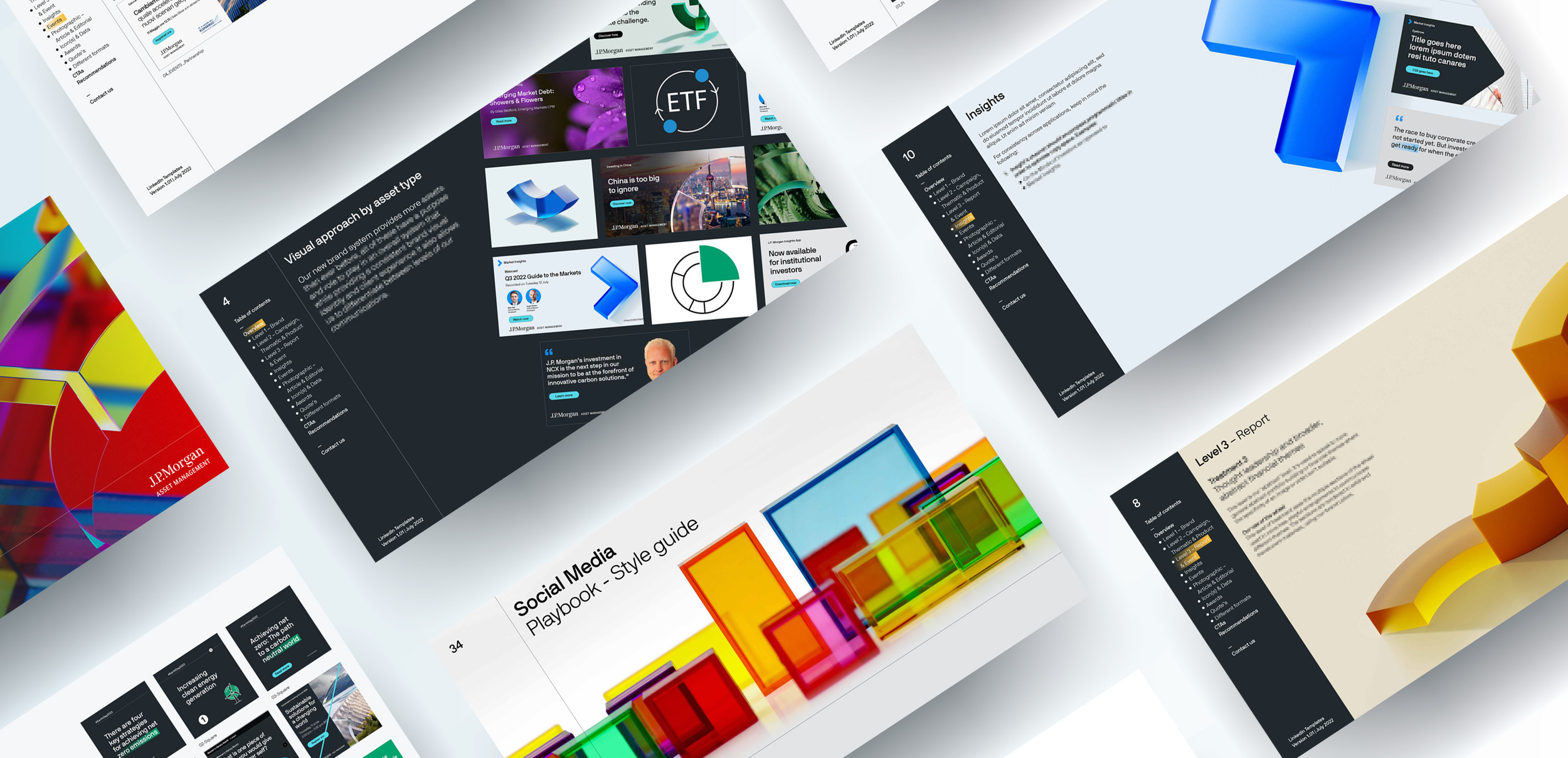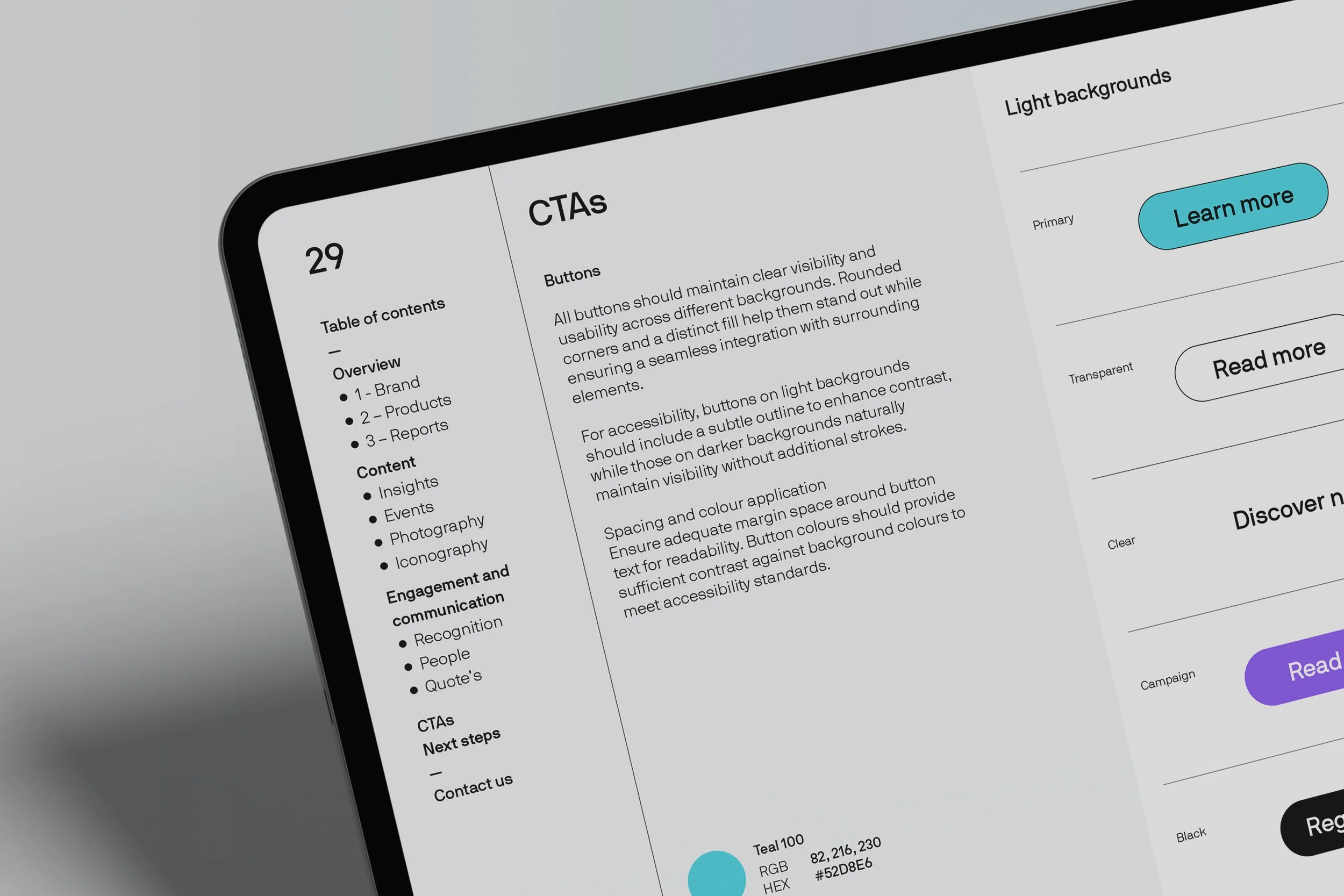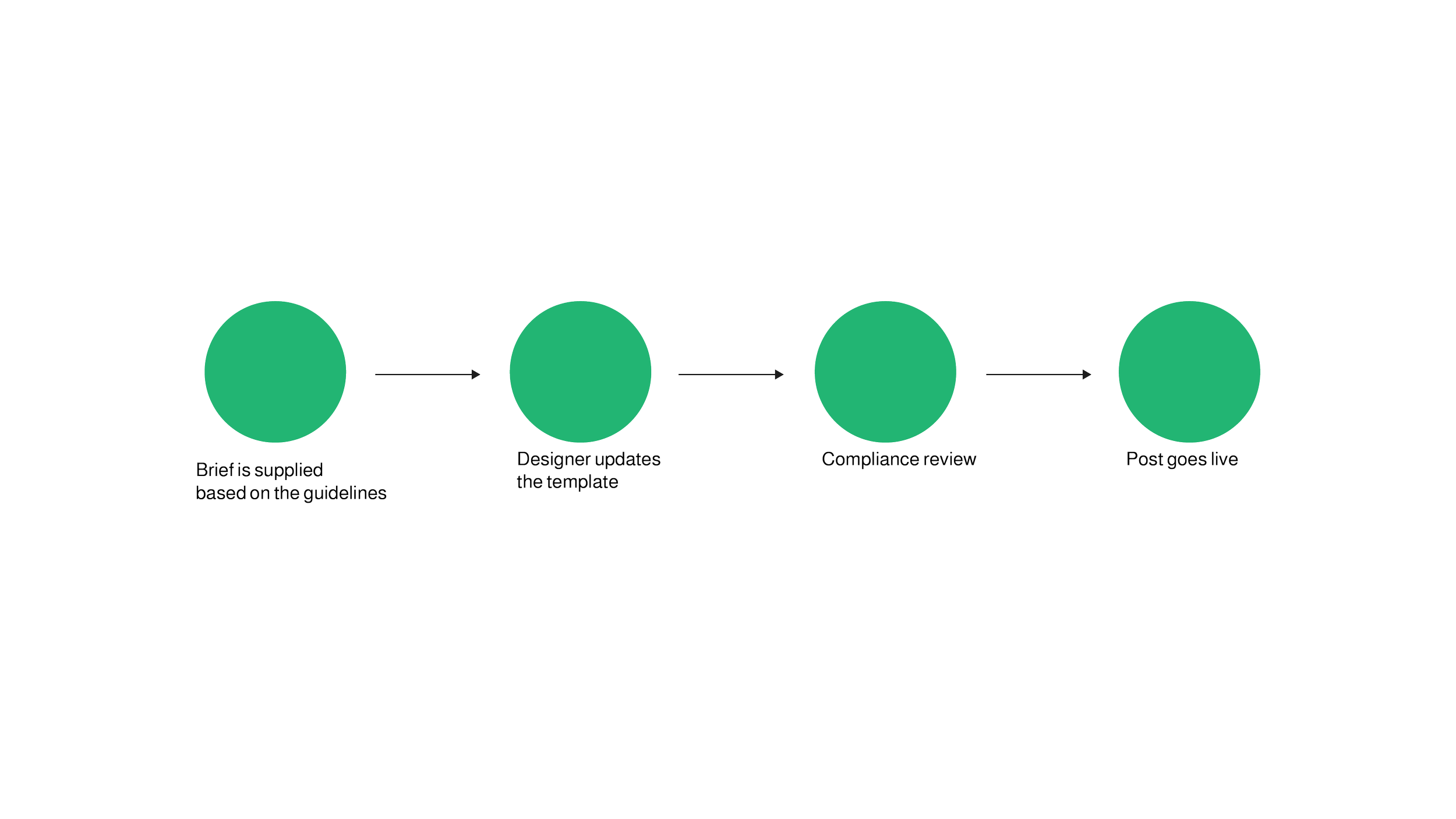
♞ Design Strategy - Case study
CLIENT
J.P.Morgan Asset Management
AGENCY
Leap
SERVICES
SERVICE DESIGN
DESIGN GOVERNANCE
DESIGN SYSTEMS
GUIDELINES
CONTENT STRATEGY
SOCIAL MEDIA
Social media playbook
Streamlining workflows and enhancing brand consistency through a unified social media guide.
Large-scale studios handle a high volume of social media content production, requiring a structured approach to ensure brand consistency and efficiency. Producing social media content at scale requires a structured approach to ensure brand consistency and efficiency. Through research and auditing, I developed a 30-page social media design system, introducing reusable templates categorised by campaign type, product, and post objective, with clear guidelines for marketers and designers.
This framework optimised workflows, reducing content creation time by 30% while enhancing brand consistency across platforms. To support adoption, I led team training sessions and workshops, equipping stakeholders with the tools to create content efficiently and effectively.
AT A GLANCE
-
Many large organizations face challenges in maintaining branding consistency and efficient workflows when producing social media content at scale. Without a structured approach, marketing teams can struggle with maintaining a cohesive visual and messaging identity, leading to inefficiencies and inconsistencies across platforms. In this scenario
Key Issues:
Inconsistent Branding: Lack of cohesion in visuals and messaging across LinkedIn and other platforms.
Inefficient Workflow: Marketers and designers could face a time-intensive process starting each campaign from scratch.
Absence of Unified Framework: Teams m lacked a centralized guide to streamline and standardize content creation.
-
To address this, I designed a 30-page Social Media Playbook that provided a structured framework for content creation.
Key Features:
Categorised Templates: Organised by campaign type, product, and post objectives.
Reusable Templates: Ready-made options for common posts, such as market insights, corporate announcements, and product launches.
Guidelines: Simple instructions on tailoring templates for various platforms like LinkedIn and Twitter.
Efficiency Tools: A step-by-step system for briefing designers.
Brand compliance and training workshop.
-
The Impact:
Reduced content creation time by 30% by eliminating redundant template development.
Strengthened brand consistency across all social media channels.
Improved cross-team collaboration, ensuring seamless execution of digital campaigns.
THE PROCESS STEP BY STEP
01 | Research & Insights
In fast-paced marketing environments, maintaining brand consistency and efficiency can be a challenge, particularly when multiple teams work across different platforms.
Without a structured system, teams may face inconsistencies in design execution, inefficiencies in content production, and difficulties in aligning messaging across platforms.
My Approach:
Audited all previous templates and assets, assessing their design consistency and usage.
Categorised templates based on:
Product focus
Post type
Levels of brand communication
Collaborated with key stakeholders to identify gaps and refine processes through targeted interviews with marketing and design teams.
Key Findings:
Brand cohesion challenges – Without a unified approach, variations in tone, visuals, and messaging can weaken brand identity across platforms.
Process inefficiencies – Teams often spend unnecessary time recreating templates, increasing production time by up to 40% due to the absence of a scalable system.
Need for a guided selection process – Content creators and designers benefit from a structured approach to selecting the right templates, ensuring alignment with brand messaging and design principles.
Optimised workflow for seamless execution – The introduction of a standardised template selection system, minimising unnecessary revisions and communication delays.
♞ STEPS TAKEN
02 | Implementation
2- Categorisation
Organised templates into key categories to streamline selection and ensure consistency. Identified which templates were suitable, which needed redesign or refinement based on brand guidelines, and where gaps existed in template coverage.
Differentiated templates accordingly and ensured all adjustments were made in alignment with the brand guidelines.
1 - Template Collection
Conducted a comprehensive audit of all existing templates to assess usage, consistency and branding alignment.
4 - Guidelines & Team training
Developed detailed guidelines for the studio
team and led interactive workshops to onboard stakeholders. Conducted hands-on training sessions to ensure seamless adoption and effective integration of the playbook into daily workflows.
3 - Playbook creation
Tested all templates for usability, consistency, and brand alignment before finalising the playbook. Designed new templates to fill gaps and refined existing ones. Worked with stakeholders to ensure branding and communication consistency. Developed a 30-page Social Media Playbook with a visual directory, clear guidelines, and practical examples.
♞ PLAYBOOK CREATION
Templates design
I began with a comprehensive audit of existing templates, assessing their effectiveness, consistency, and alignment with brand guidelines. This process identified opportunities to refine designs, eliminate redundancies, and address missing assets.
Building on these insights, I redesigned templates where necessary and developed new ones to enhance usability, ensuring they met both brand standards and production needs. Each template was rigorously tested in real-world scenarios to validate versatility and consistency across platforms. Feedback from the studio and marketing teams informed the final refinements, improving clarity, adaptability, and efficiency. The completed system provided a structured, scalable approach to social media design, ensuring seamless execution across diverse content types.
Document development
With the finalised templates in place, I developed a 30-page Social Media Playbook to provide clear guidelines on template usage. The goal was to create a structured, easy-to-use resource that enabled teams to work efficiently while maintaining brand consistency.
The playbook served as both a reference manual and a practical tool, featuring:
Visual Directory – A clear, organised catalog of templates, categorised by content type and campaign objective for quick selection.
Usage Guidelines – Instructions on selecting, customising, and adapting templates for different platforms, covering text placement, image specifications, and colour usage.
Best Practices & Do’s and Don’ts – Recommendations for formatting, messaging, and brand tone to ensure consistency across all channels.
To ensure seamless adoption, I developed team-specific guidelines for the studio team, marketing team, and compliance reviewers, clarifying their roles and optimising content creation workflow.
♞ POST-PRODUCTION
Guidelines development and team training
I developed clear, structured guidelines by integrating key elements from the brand guidelines to ensure consistency. They provided step-by-step instructions, practical examples, and do’s and don’ts, balancing creative flexibility with brand standards. This streamlined content creation for both marketers and designers.
Team training
As the final stage, I led interactive workshops to ensure seamless adoption of the playbook. Through real-world scenarios, I guided marketers and designers in template selection, customisation, and best practices. The sessions also incorporated key brand guidelines, reinforcing consistency while allowing flexibility for different content needs.
♞ STEPS TAKEN
03 | Key Improvements
In large-scale content production, inefficiencies often stem from unstructured workflows. A possible hypothesis is that adopting a structured selection system, where stakeholders choose from pre-approved templates, enhances efficiency and brand consistency. By providing clear guidelines, this approach could reduce revisions, streamline approvals, and improve overall workflow efficiency. Testing this in different creative environments could validate its impact on collaboration and content production speed.
Original Workflow (Left - Red):
Lack of a defined starting point led to inconsistencies in design selection.
Multiple approval loops extended timelines and increased workload.
Compliance reviews occurred late in the process, leading to last-minute adjustments.
New Workflow (Right - Green):
A clear template selection process provided structure from the outset, ensuring brand consistency.
Designers worked within predefined guidelines, reducing the need for extensive revisions.
A more integrated review system facilitated smoother collaboration between marketing and compliance, enabling faster approvals.




























